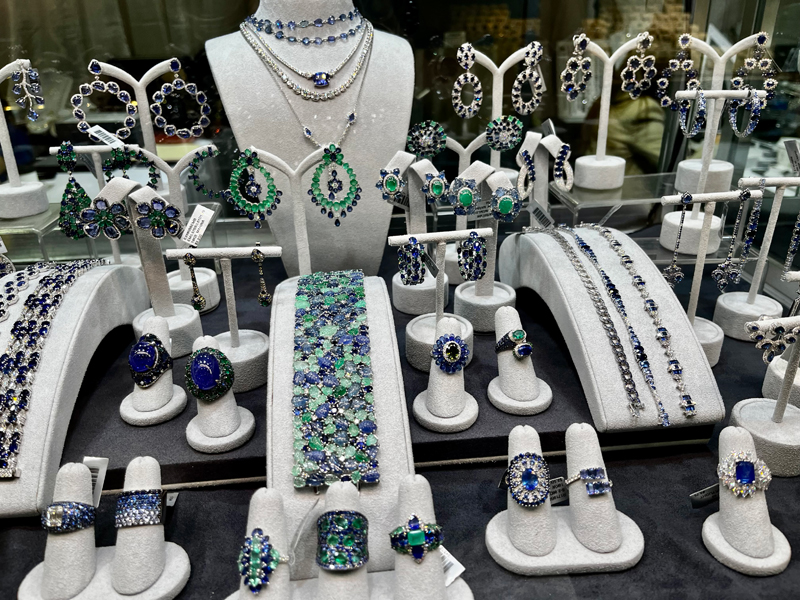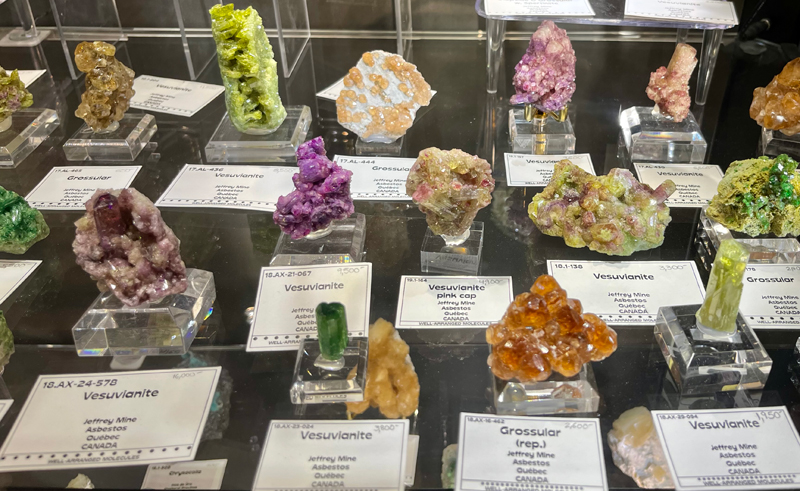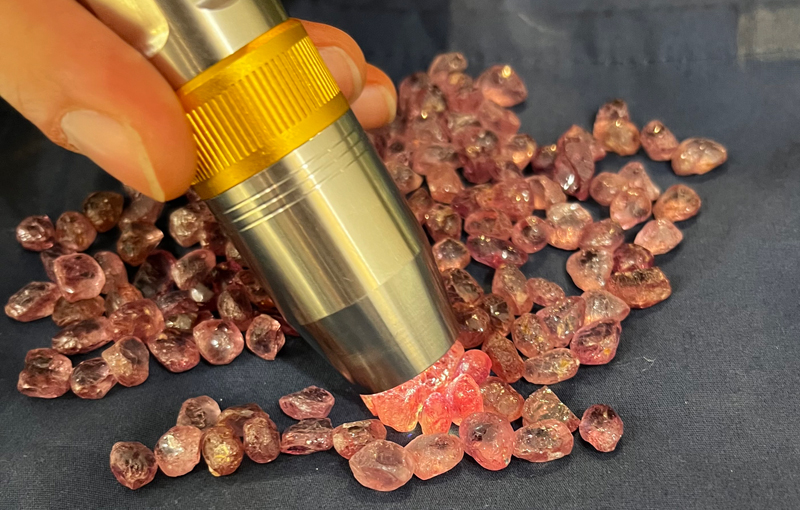By Lauriane Lognay

Photos by Lauriane Lognay/Rippana, Inc.
Upon reading the title of this column, I’m sure many of you are thinking, “Why, Lauriane—the Tucson gem shows came back last year!” While there certainly were events in 2022 (and they were great), the show’s essence and its life from all over the world was muted. Namely, Tucson 2022 saw less of its usual international attendees from Sri Lanka, India, China, Japan, and more. The absence was palpable and, while those in attendance were grateful the show was taking place at all, worry remained in the air.
This year, I can say with confidence we felt the return of the Tucson GemFair spirit. The gemstone and jewellery crowd gathered together again, and the minerals and gems were plentiful (along with the prices, much to our dismay). We grouped together with friends—many of whom we hadn’t seen in more than three years. Parties were in full swing all month and smiles were distributed freely.
Speaking of parties…
This year, the American Gem Trade Association (AGTA) celebrated its 40th anniversary in what is actually its 42nd year. The group refrained from formally celebrating its four-decade milestone the past two years for a multitude of reasons (mainly, of course, the pandemic and the absence of many international attendees). As such, AGTA’s much-anticipated, belated anniversary party was a well attended and joyful celebration.
The Accredited Gemologists Association (AGA) Gala dinner was another Tucson party of note. The event brought together the most recent recipient of the Antonio C. Bonanno Award for Excellence in Gemology alongside past honourees, creating a world-renowned super group of legendary gemmologists. The award, which was established to celebrate those who have made significant contributions to the field of gemmology, was presented to none other than former International Colored Gemstone Association (ICA) CEO, Gary A. Roskin, GG (GIA), FGA, who is also an author, journalist, and one of the world’s most highly regarded authorities in the art and science of diamond grading. Congratulations to him!
Speaking of ICA, the association held a gala this year in remembrance of Jean Claude Michelou, the former editor-in-chief of ICA’s InColor Journal. Michelou, who was the co-founder of Thailand-based coloured gemstone supplier, Imperial Colors, Ltd., passed away in 2021 at the age of 72. ICA held the gala dinner in celebration off all Michelou accomplished and contributed to the gemstone industry.
This year also saw the return of the Gemology Worldwide meeting. The party invites the gem-loving members of its Facebook group to partake in a drink and talk gemstones and jewellery fashion. It’s always a pleasure to see friends and familiar faces amongst the crowds of enthusiasts.
Such events, while numerous in Tucson, hold an important place in the spirit of the GemFair. Indeed, these parties are the perfect opportunity to network and meet others who feel passionate about this industry.

Canada and the U.S.: A (gemstone) love story
Recent years have seen an influx of interest in Canadian gemstones amongst our friends south of the border—and I’m not just talking about the rainbow ammolite and ammonite gems and fossils that grace Tucson with their presence each year. Indeed, beyond these long-standing favourites, there has been a definite rise in popularity for hessonite and demantoid garnet, vesuvianite, Gaspéite, Amazonite, and other gems found in the Great White North.1
Additionally, since the closing of Québec’s Jeffrey Mine in Asbestos (now Val-des-Sources), the rarity of specimens versus the demand in the American market has only gone up. While this is noticed less at larger jewellery shows, such as AGTA or the Gem and Jewelry Exchange (GJX), other niche events (such as Mineral City and 22nd Street Mineral, Fossil, Gem & Jewelry Show) are wonderful opportunities for those on the hunt for specific minerals. Even smaller thumbnail specimens can fetch big prices on the American market, if they possess the quality and colour desired.
Treasures and discoveries
I am always on the lookout for unusual discoveries in Tucson, and this year did not disappoint. I came across many interesting gems during my pilgrimage—some newly discovered and others just arriving on the market—along with other curiosities. This is what I always look forward to in Tucson: new and rare materials, novel treatments, and intriguing imitations entering the market worldwide, via the GemFair.
Amazon green opal
While common green opal has been around for decades (though not much in the jewellery industry), the colour, quality, and origin of a certain batch of specimens on display this year was certainly noteworthy. The rough, found in the Amazon rainforest in Brazil, has a pleasing green colour with some black inclusions. While most is opaque, some has a translucent quality to it that could be faceted.
Hyalite opal from Mexico
Also marketed as “kryptonite,” hyalite is a colourless to pale green or yellowish variety of opal which has a strong bright green fluorescence under ultra-violet (UV) light. Like Amazon green, hyalite opal has been around for some time; however, for many years, it remained extremely hard to find at shows in good qualities. It is considered a good collector item to have for fans of unusual gems or opals. This year, I was surprised to see more of it in one week than I have at the past seven Tucson shows.

Garnet
I noticed two new types of garnet circulating (but hard to find) in Tucson.
The first—called “dragon” garnet from Tanzania—shows an unusual strong reaction under UV light. I was able to set eyes on rough specimens, but no cut stones to speak of. Those, I expect, will be available next year. The president of American Gemological Laboratories (AGL) in New York was the one to confirm the find, with a chromium-vanadium composition from Malaya. (This, to me, is reminiscent of the 2017 discovery of a new type of blue garnet also containing vanadium,2 but more of the spessartite pyrope type.) Dragon garnet can show a colour shift—from lavender in daylight, to orangey pink in iridescent light. The reaction under UV light shows a strong saturated red to pale-red colour.
The second garnet variety I consider to be of note this year also demonstrates unusual colour change, but in the form of an Usambara effect.3 This rare occurrence is most often found in green tourmaline. It happens when a light is shined through the back of one of these stones and the spot illuminated turns red because of a shift in the crystalline structure. Historically, this optical phenomenon is rarely—if ever—seen in a garnet. It will be interesting to see what future studies make of it.
Hackmanite from Afghanistan
A type of sodalite, hackmanite is found in a few places around the world, though most of the best varieties are from Canada. It is also sourced from the United States, Norway, and Myanmar.
Hackmanite found in Afghanistan is facet quality, making it beyond rare. The base colour is soft lavender to dark purple, and the gemstone has an optical phenomenon called tenebrescence.3 Placing the stone under UV light for a few seconds, effectively, “charges it,” which causes the colour to darken to a deep purple. The change will stay for anywhere from a couple of minutes to a few hours, with some specimens maintaining the colour for longer than 24 hours. With its hardness of 5.5 to 6 on the Mohs scale (and with three to six cleavage planes), hackmanite is not suited for beginners.
Passion quartz
Among the smaller (but no less fun) recent discoveries is that of a pink type of quartz found in the Italian Alps. Dubbed “passion quartz,” this variety features inclusions of rhodonite and spessartite garnet, which creates an opaque milky-white look with bands of soft pink.
Another year, another Tucson
If only one thing could be said about this year’s Tucson GemFair, it’s that the events comprise, without a doubt, the most significant gem show around, as well as the largest gathering of jewellers and gemmologists from around the world. Passion made this show happen—and the same passion will make it continue.
 Lauriane Lognay is a fellow of the Gemmological Association of Great Britain (FGA) and has won several awards. She is a gemstone dealer working with jewellers to help them decide on the best stones for their designs. Lognay is the owner of Rippana, Inc., a Montréal-based company working in coloured gemstone, lapidary, and jewellery services. She can be reached at rippanainfo@gmail.com.
Lauriane Lognay is a fellow of the Gemmological Association of Great Britain (FGA) and has won several awards. She is a gemstone dealer working with jewellers to help them decide on the best stones for their designs. Lognay is the owner of Rippana, Inc., a Montréal-based company working in coloured gemstone, lapidary, and jewellery services. She can be reached at rippanainfo@gmail.com.
References
1 For more, see “The wonders of Canada” by Lauriane Lognay, published in the August 2019 edition of Jewellery Business. Find it online here: https://www.jewellerybusiness.com/features/the-wonders-of-canada
2 Lognay, L. New horizons: How fresh discoveries push the gemstone industry forward. Jewellery Business, 2019 October; 14(5), 14-18. https://www.jewellerybusiness.com/features/new-horizons-how-fresh-discoveries-push-the-gemstone-industry-forward
3 Lognay, L. A gift from nature: The 10 optical phenomena of gemmology. Jewellery Business, 2021 July; 17(3), 8-12. https://www.jewellerybusiness.com/gemstonesgemmology/a-gift-from-nature-the-10-optical-phenomena-of-gemmology





